Abstract
In this paper, the fractional equations of the mass-spring-damper system with Caputo and Caputo–Fabrizio derivatives are presented. The physical units of the system are preserved by introducing an auxiliary parameter σ. The input of the resulting equations is a constant and periodic source; for the Caputo case, we obtain the analytical solution, and the resulting equations are given in terms of the Mittag–Leffler function; for the Caputo–Fabrizio approach, the numerical solutions are obtained by the numerical Laplace transform algorithm. Our results show that the mechanical components exhibit viscoelastic behaviors producing temporal fractality at different scales and demonstrate the existence of material heterogeneities in the mechanical components. The Markovian nature of the model is recovered when the order of the fractional derivatives is equal to one.
1. Introduction
In recent years, fractional calculus (FC) has been increasingly applied in different fields of science [1,2,3,4,5,6,7]. Physical phenomena related to electromagnetism, propagation of energy in dissipative systems, thermal stresses, models of porous electrodes, relaxation vibrations, viscoelasticity and thermoelasticity are successfully described by fractional differential equations [8,9,10,11,12,13,14,15,16,17,18,19]. FC allows for the investigation of the nonlocal response of mechanical systems, this is the main advantage when compared to the classical calculus. Some research concerning classical mechanics introduces FC, for example in [20], the authors investigated the relationship of the Fourier transform of fractional order to harmonic oscillation. Ryabov in [21] studied the fractional oscillator engaging the Riemann–Liouville fractional derivative. In [22], the authors found the analytical solution of the fractional damped oscillator equation using the Caputo derivative. In [23], Stanislavsky dealt with generalization of the mechanical oscillator using fractional derivatives. Tarasov in [24] considered the oscillator of fractional order as a system with memory; the author suggested independent harmonic oscillators to define the environment. Caputo in [25] studied the classic second order differential equation of the damped oscillator; using this model, the author quantifies the response and the decaying oscillations of a seismograph and applied the FC approach; this model introduces the mathematical memory operator represented by the fractional order derivative in order to model the response curves of more complex instruments realistically. Recently, in [26], the mass-spring and the spring-damper systems without the source term were analyzed; the authors considered fractional time derivatives of the Caputo type. Other applications of FC to mechanical oscillators are given in [27,28,29].
In the literature, a number of definitions of the fractional derivatives have been introduced, namely the Hadamard, Erdelyi–Kober, Riemann–Liouville, Riesz, Weyl, Grünwald–Letnikov, Jumarie and the Caputo representation [30,31,32,33]. A thorough analysis of fractional dynamical systems is necessary to achieve an appropriate definition of the fractional derivative. For example, the Riemann–Liouville definition entails physically unacceptable initial conditions (fractional order initial conditions) [34]; conversely, for the Caputo representation, the initial conditions are expressed in terms of integer-order derivatives having direct physical significance [35]; this definition is mainly used to include memory effects. Recently, Michele Caputo and Mauro Fabrizio in [36] presented a new definition of the fractional derivative without a singular kernel; this derivative possesses very interesting properties, for instance the possibility to describe fluctuations and structures with different scales. Furthermore, this definition allows for the description of mechanical properties related to damage, fatigue and material heterogeneities. The properties of this new fractional derivative are reviewed in detail in the paper [37]. Recently, Abdon Atangana and Badr Alkahtani [38,39] studied the resistor–inductor–capacitor electrical circuit and the Keller–Segel model based on the Caputo–Fabrizio definition; in both works, the authors showed the application of the new proposed fractional derivative without a singular kernel.
In the present work, we use both the Caputo and the Caputo–Fabrizio fractional derivatives to present the analytical and numerical solutions of the mass-spring-damper systems for different source terms; the idea proposed in [26] is applied to construct the fractional differential equations, and our representation preserves the physical units of the physical system for any value by the fractional derivative exponent. The main reason for this work is to investigate and model the displacement of the oscillator in fractal geometries using the fractional derivative with a singular kernel (Caputo approach) and the fractional derivative without a singular kernel (Caputo–Fabrizio approach).
2. Basic Concepts
The Caputo derivative (CD) is defined as follows [32]:
where = is a CD with respect to t, φϵR is the order of the fractional derivative and represents the gamma function.
The Laplace transform of the CD has the form [32]:
Some common Laplace transforms are:
The Mittag–Leffler function [40] is defined by a power as:
The Caputo–Fabrizio derivative (CF) is defined as follows [36,37]:
where = is a CF with respect to t, is a normalization function, such that ; in this definition, the derivative of a constant is equal to zero, but unlike the usual Caputo definition (1), the kernel does not have a singularity at .
If and , the CF fractional derivative, , of order is defined by:
The Laplace transform of (7) is defined as follows [36,37]:
for this representation in the time domain, it is suitable to use the Laplace transform [36,37].
From this expression, we have:
3. Mass-Spring-Damper System
According to [26], to be consistent with the dimensionality of the physical equation, an auxiliary parameter σ is introduced into the fractional temporal operator:
and:
where γ represents the order of the fractional temporal operator and σ has the dimension of seconds. The auxiliary parameter σ is associated with the temporal components in the system (these components change the time constant of the system) [41]; for the case , Expressions (13) and (14) become ordinary temporal operators. Following this idea, the equation of the mass-spring-damper system represented in Figure 1 is given by:
and for the CF, we have:
where the mass is m, the damping coefficient is β, the spring constant is k and represents the forcing function.
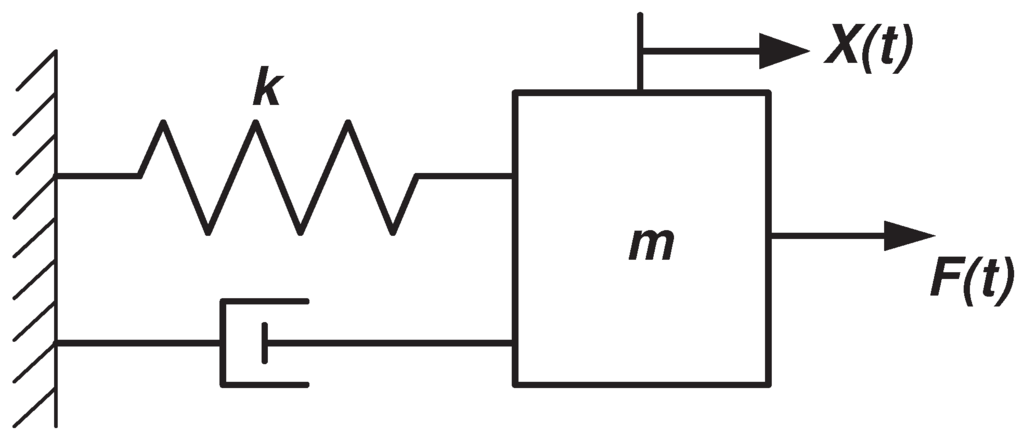
Figure 1.
Mass-spring-damper system.
From Equations (15) and (16), we derive the particular cases:
- Mass-spring system,and:
- Damper-spring system, :and:
Now, we obtain the analytic and numerical solutions of Equations (15)–(16) corresponding to the particular Cases 1 and 2 for different source terms.
3.1. Mass-Spring System
Case 1: Consider a constant source, , , , ; Equation (17) may be written as follows:
where:
is the fractional angular frequency and is the frequency in the classical case.
The solution of (21) is:
where is given by (6).
Concerning the classical case, from (22), we have ; then, the solution of Equation (21) is:
In this case, a physical relationship exists between Equation (17), the order γ and σ:
For Expression (25), the solution (23) is given by:
The plots for different values of the fractional order γ are shown in Figure 2.
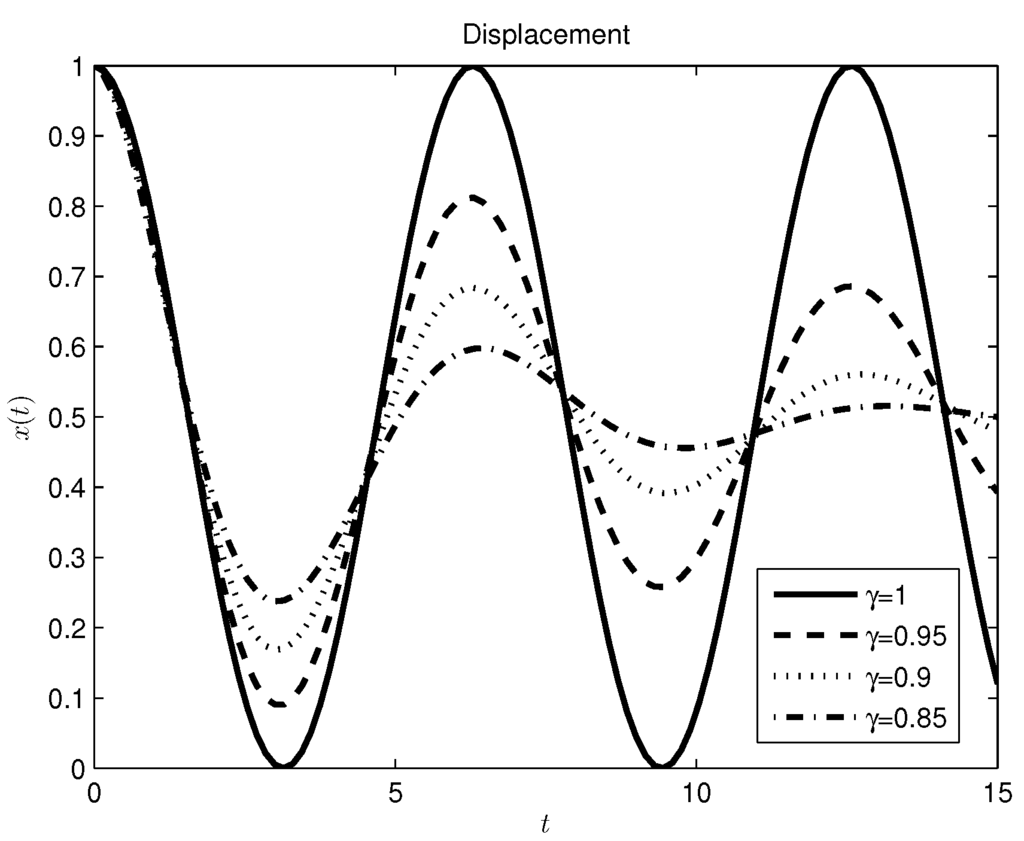
Figure 2.
Mass-spring system with a constant source, Caputo derivative approach.
For Equation (18), we have:
the Laplace transform (10) of (27) yields:
applying the numerical inverse Laplace transform algorithm [42] to (28), we obtain the time response. The plots for different values of the fractional order γ are shown in Figure 3.
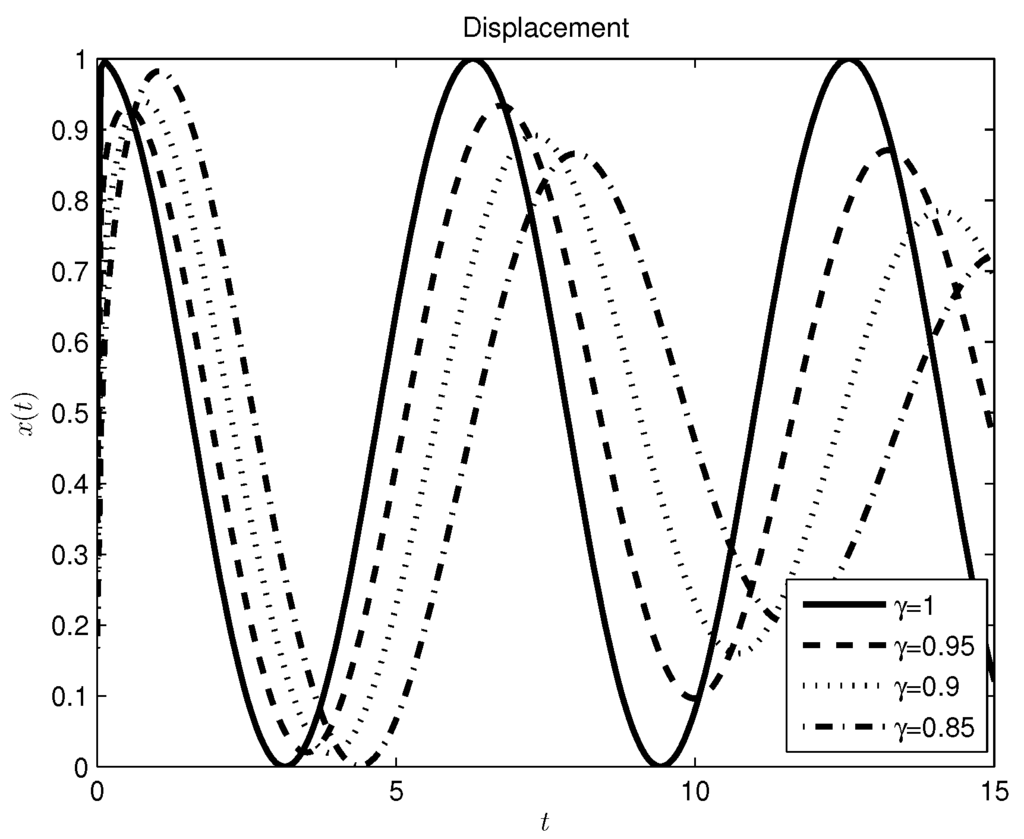
Figure 3.
Mass-spring system with a constant source, Caputo–Fabrizio derivative approach.
Case 2: Consider a periodic source, , , , ; Equation (17) may be written as follows:
where is given by (22).
The solution of Equation (29) is:
where is given by (6).
For the classical case, from (22), we have ; the solution of Equation (29) is:
Taking into account Expression (25), the solution (30) is:
The plots for different values of the fractional order γ are shown in Figure 4.
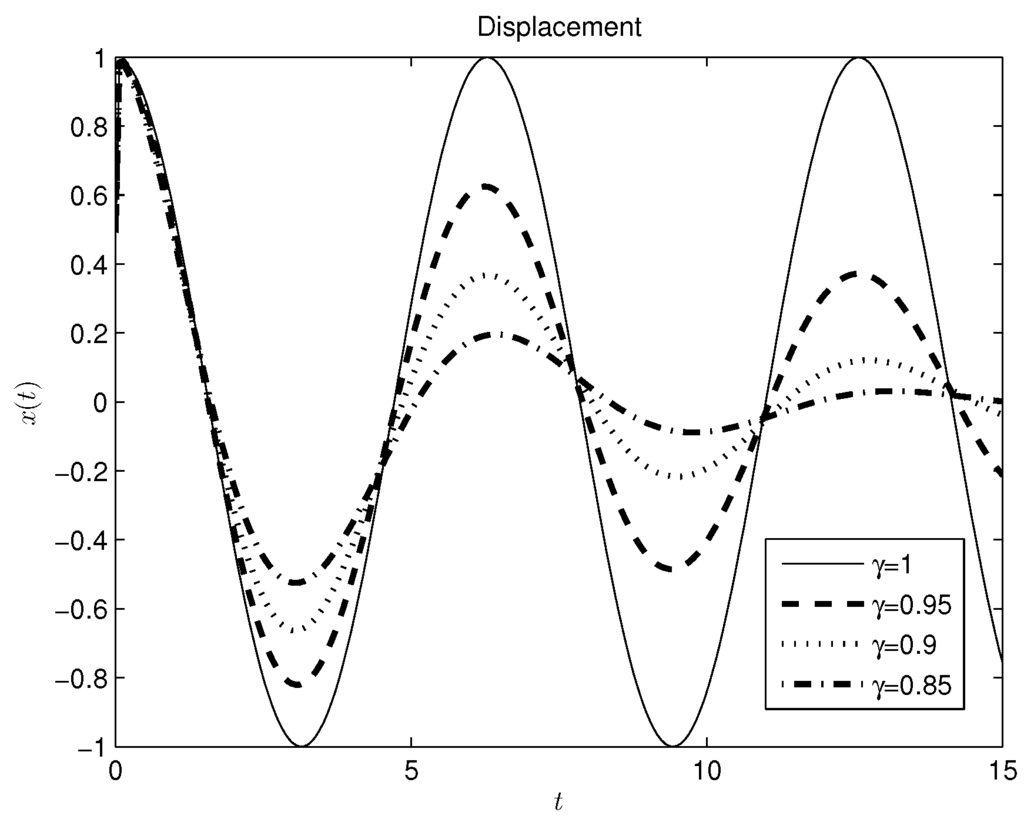
Figure 4.
Mass-spring system with a periodic source, Caputo derivative approach.
For Equation (18), we have:
the Laplace transform (10) of (33) yields:
applying the numerical inverse Laplace transform algorithm [42] to (34), we obtain the time response. The plots for different values of the fractional order γ are shown in Figure 5.
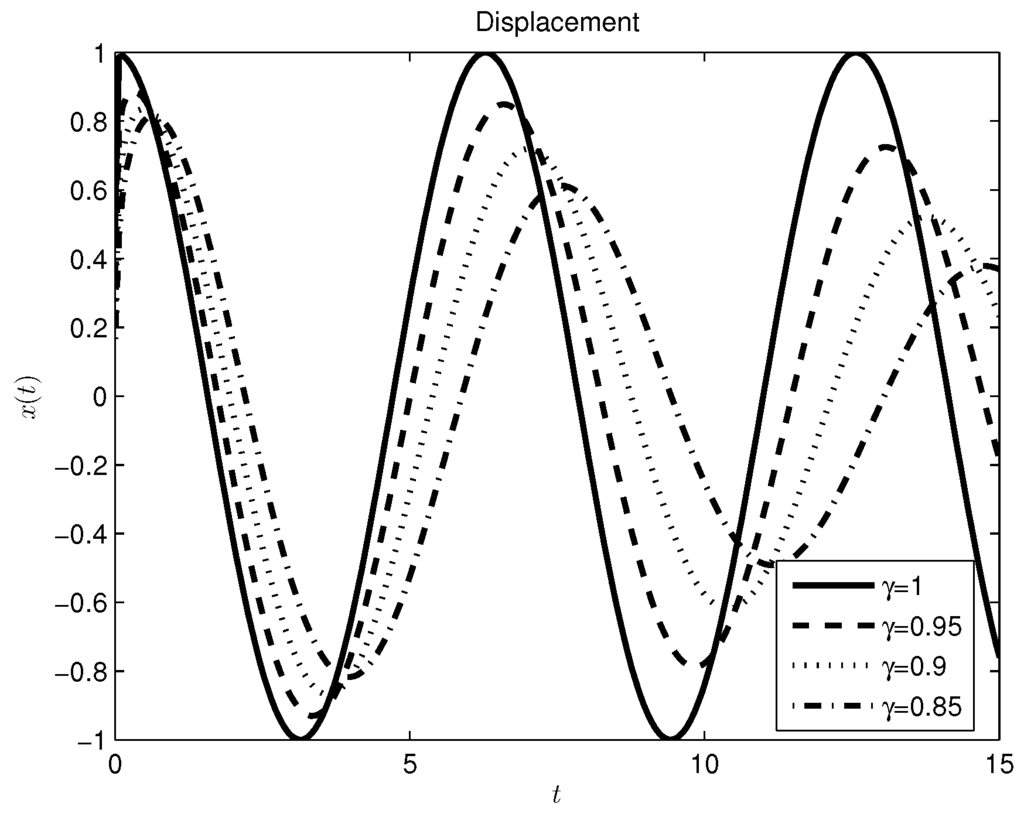
Figure 5.
Mass-spring system with a periodic source, Caputo–Fabrizio derivative approach.
3.2. Damper-Spring System
The solution for Equation (35) is:
where is given by (6).
For the classical case, Expression (37) becomes:
In this case, there is a physical relation between Equation (19), the order γ and σ:
considering Expression (39); the solution (37) is:
The plots for different values of the fractional order γ are shown in Figure 6.
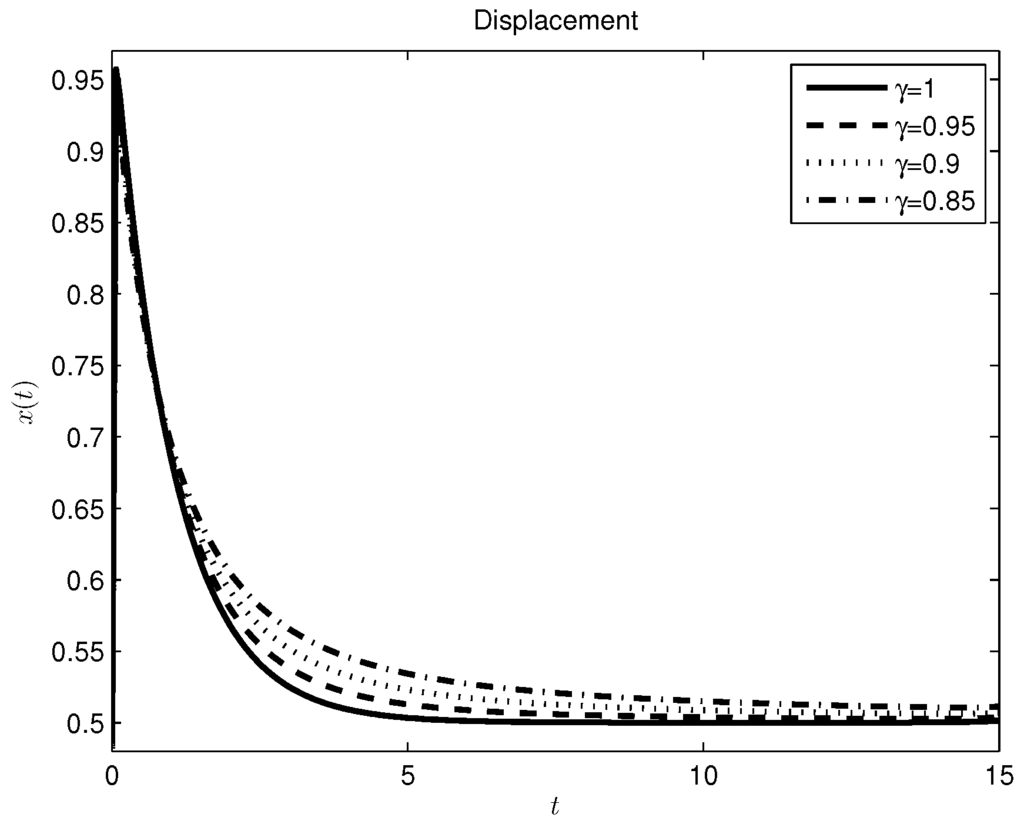
Figure 6.
Damper-spring system with a constant source, Caputo derivative approach.
For Equation (20), we have:
the Laplace transform (10) of (41) yields:
applying the numerical inverse Laplace transform algorithm [42] to (42), we obtain the time response. The plots for different values of the fractional order γ are shown in Figure 7.
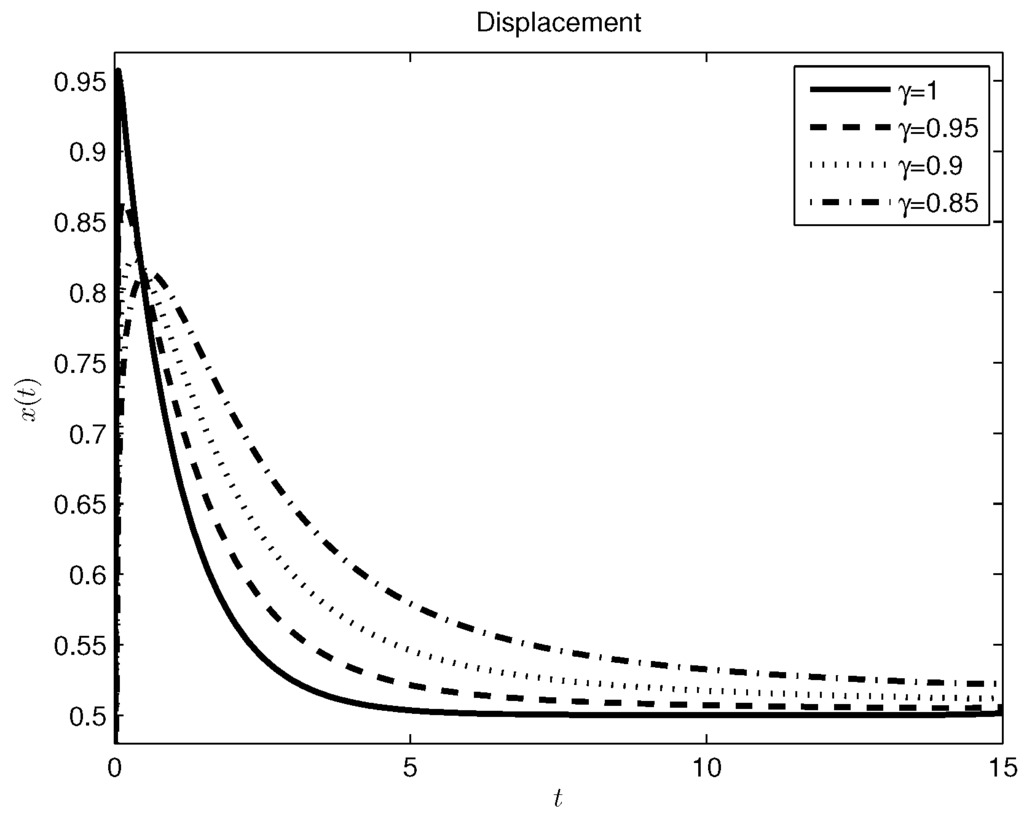
Figure 7.
Damper-spring system with a constant source, Caputo–Fabrizio derivative approach.
Case 2: Consider a periodic source, , , ; Equation (19) may be written as follows:
the solution for Equation (43) is:
where is given by (6).
For the classical case, Expression (44) becomes:
considering Expression (39), the solution (44) is:
the plots for different values of the fractional order γ are shown in Figure 8.
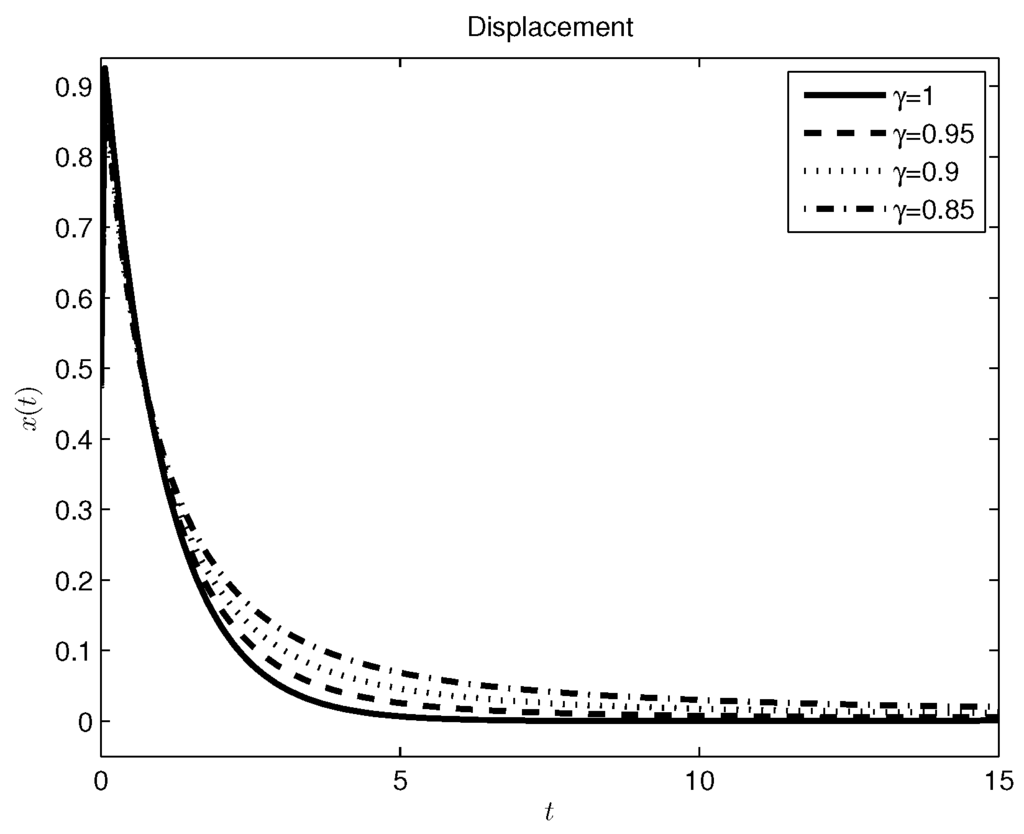
Figure 8.
Damper-spring system with a periodic source, Caputo derivative approach.
For Equation (20), we have:
the Laplace transform (10) of (47) is:
applying the numerical inverse Laplace transform algorithm [42] to (48), we obtain the time response. The plots for different values of the fractional order γ are shown in Figure 9.
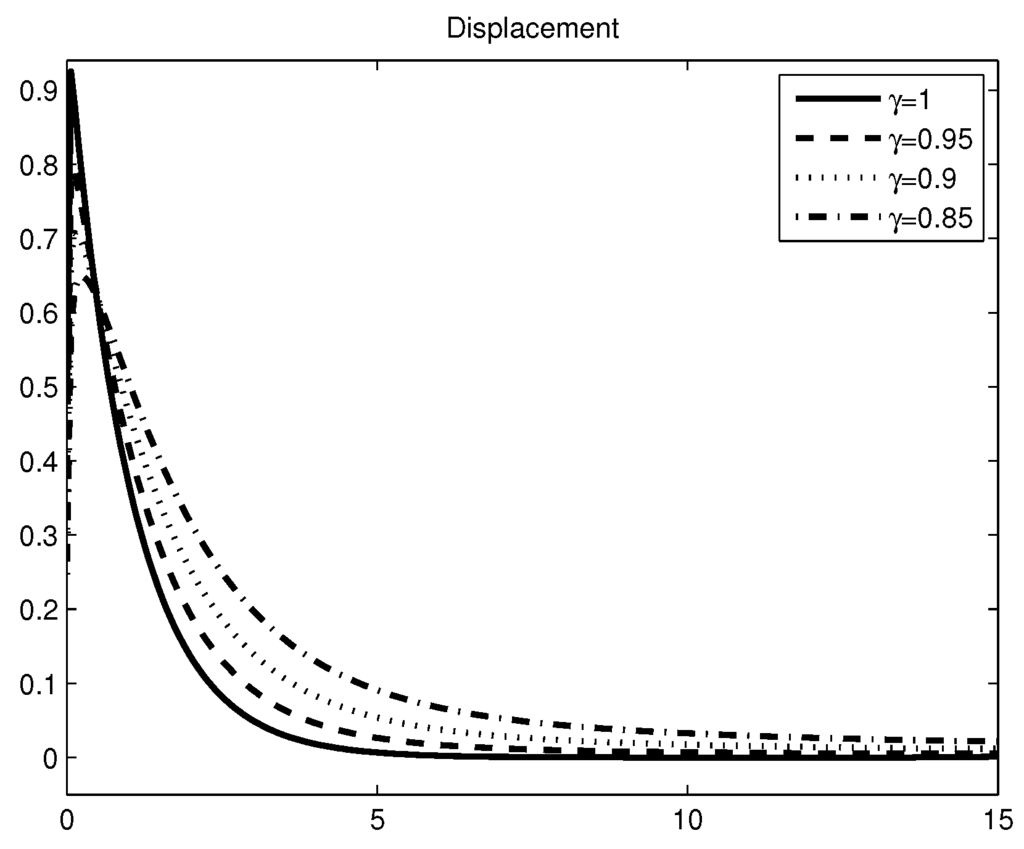
Figure 9.
Damper-spring system with periodic source, Caputo–Fabrizio derivative approach.
3.3. Mass-Spring-Damper System
Case 3: Consider and initial conditions equal to zero; Equation (15) may be written as follows:
where and τ are given by (22) and (36), respectively. The solution of Equation (49) is:
where is given by (6).
For the classical case, Expression (50) becomes:
In this case, there is a physical relation between Equation (15), the order γ and σ:
considering Expression (52), the solution (50) is:
The plots for different values of the fractional order γ are shown in Figure 10.
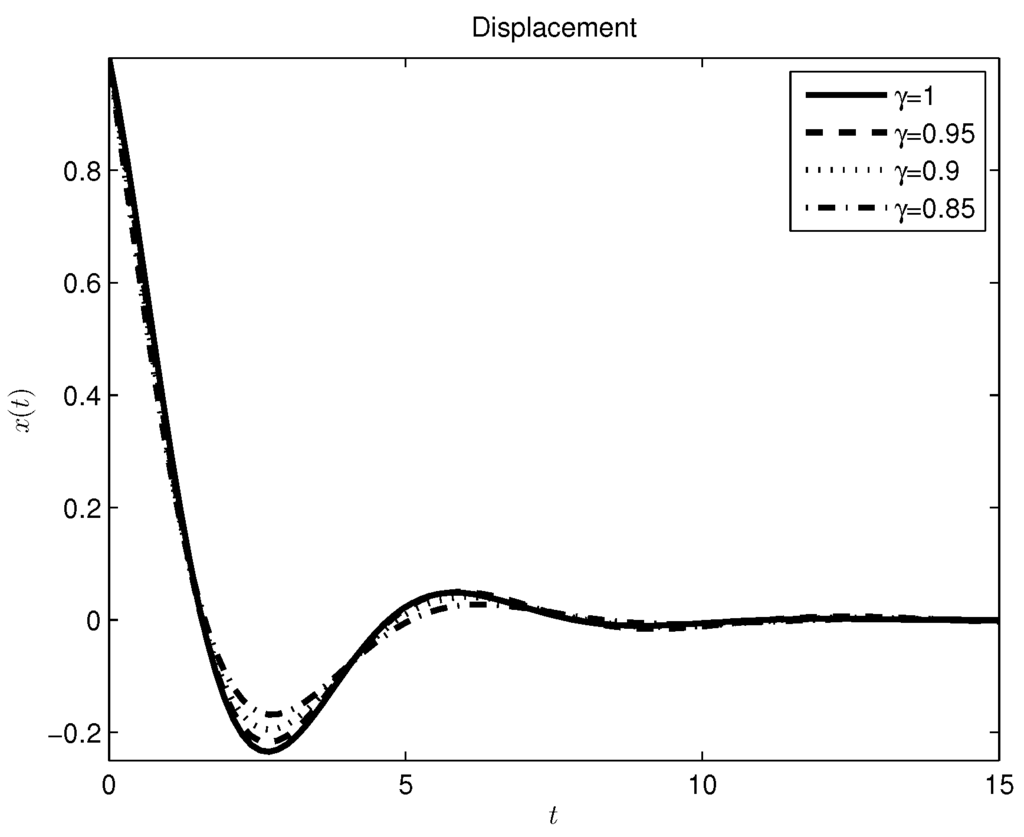
Figure 10.
Mass-spring-damper system without a source, Caputo derivative approach.
For Equation (16), we have:
and the Laplace transform (10) of (54) yields:
where and τ are given by (22) and (36), respectively. Applying the numerical inverse Laplace transform algorithm [42] to (55), we obtain the time response. The plots for different values of the fractional order γ are shown in Figure 11.
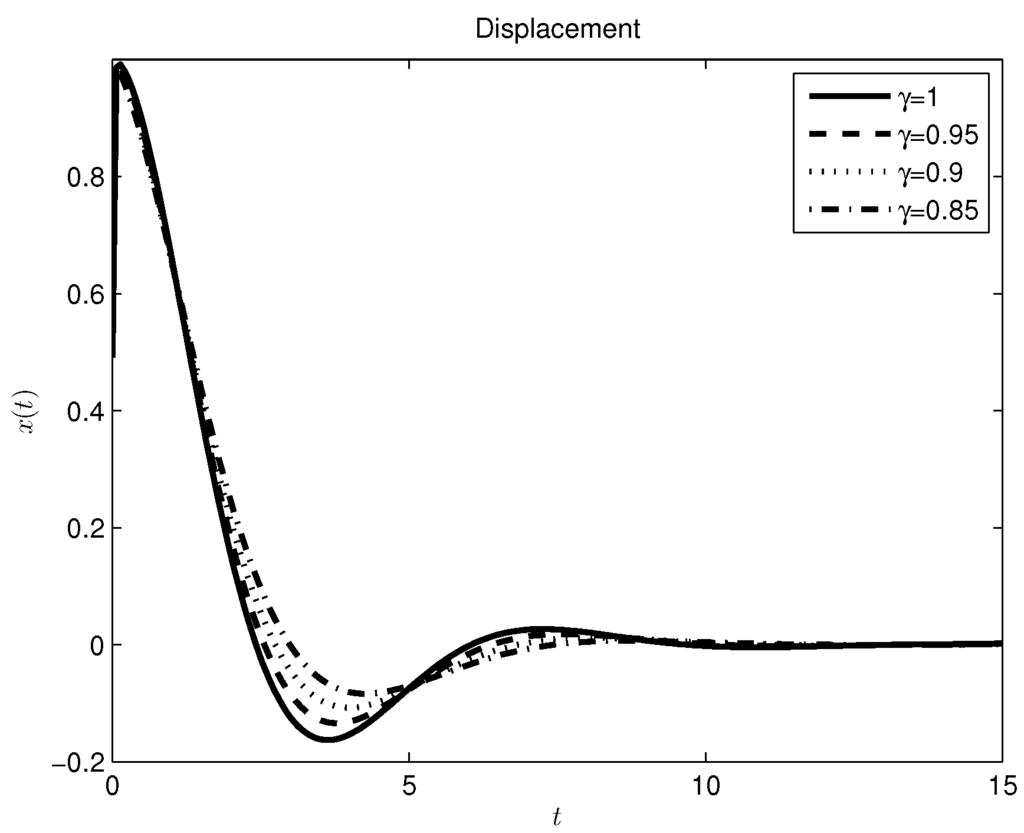
Figure 11.
Mass-spring-damper system without a source, Caputo–Fabrizio derivative approach.
4. Conclusion
In this work, we present alternative fractional differential equations using Caputo and Caputo–Fabrizio fractional derivatives for modeling oscillating systems. The proposed equations provide a universal behavior (see Equations (25), (39) and (52)); the solutions presented preserve the dimensionality of the studied system for any value of the exponent of the fractional derivative. The advantage of this alternative representation when compared to the models presented in the literature is the physical compatibility of the solutions.
For the classical Caputo approach, the solutions incorporate and describe long-term memory effects (attenuation or dissipation); these effects are related to an algebraic decay related to the Mittag–Leffler function; when γ is less than one, the fractional differentiation with respect to time represents the non-local displacement effects of dissipation of energy (internal friction) represented by the fractional order γ, which is related to the displacement of the oscillator in fractal geometries. For the Caputo–Fabrizio fractional derivative, the numerical solutions show a change of the amplitude variation and the phase; these behaviors depend on the fractional derivative order and modify the constant time; particularly, when the fractional operator is less than one, the systems exhibit a fast stabilization. This new fractional definition allows describing the relaxation phenomena characteristic of viscoelastic materials, and the numerical solution exhibits temporal fractality at different scales, as well as the existence of material heterogeneities in the mechanical components. The two definitions of fractional derivatives must apply conveniently depending on the materials treated; the choice of the fractional derivative depends upon the problem studied and on the phenomenological behavior of the system. For both definitions, when , the displacement has the ordinary behavior.
The results gathered in Figure 2, Figure 3, Figure 4, Figure 5, Figure 6, Figure 7, Figure 8, Figure 9, Figure 10 and Figure 11 briefly show that when , the system displays the Markovian nature. However, for values of , the equations describe systems that are non-conservative (non-local in time); in this context, the different γ values are modified the time constant of the systems and exhibit fractional structures (components that show an intermediate behavior between a system that is conservative and dissipative). In the range , the figures show that the system presents dissipative effects that correspond to the nonlinear situation of the physical process (realistic behavior that is non-local in time). In these cases, the systems modified the damping capacity, for example when , the damping capacity is bigger than when . Furthermore, the figures show that the Caputo fractional derivative is more affected by the past compared to the Caputo–Fabrizio fractional derivative, which shows a rapid stabilization.
The resulting equations represent a generalization of the classical mass-spring-damper model; the proposed representation can be used to describe a wide variety of systems, which had not been addressed due to the limitations of the classical calculus. In this context, we consider that these results are useful to understand the behavior of dynamical complex systems, mechanical vibrations, control theory, relaxation phenomena, viscoelasticity, viscoelastic damping and oscillatory processes.
Acknowledgments
The authors appreciate the constructive remarks and suggestions of the anonymous referees, which helped to improve the paper. We would like to thank Mayra Martínez and Dumitru Baleanu for the interesting discussions. José F. Gómez-Aguilar acknowledges the support provided by CONACYT (México): cátedras CONACYT para jovenes investigadores 2014.
Author Contributions
The analytical results were worked out by José F. Gómez-Aguilar, Huitzilin Yépez-Martínez and Ricardo F. Escobar-Jiménez. The numerical simulations were run by José F. Gómez-Aguilar, Celia Calderón-Ramón and Ines Cruz-Orduña. Ricardo F. Escobar-Jiménez and Victor H. Olivares Peregrino polished the language and were in charge of technical checking. José F. Gómez Aguilar, Huitzilin Yépez-Martínez, Celia Calderón-Ramón, Ines Cruz-Orduña, Ricardo F. Escobar-Jiménez and Victor H. Olivares Peregrino wrote the paper. All authors have read and approved the final manuscript.
Conflicts of Interest
The authors declare no conflict of interest.
References
- Baleanu, D.; Güvenc, Z.B.; Machado, J.A.T. New Trends in Nanotechnology and Fractional Calculus Applications; Springer: Berlin/Heidelberg, Germany, 2010. [Google Scholar]
- Valério, D.; Machado, J.A.T.; Kiryakova, V. Some pioneers of the applications of fractional calculus. Fract. Calc. Appl. Anal. 2014, 17, 552–578. [Google Scholar] [CrossRef]
- Machado, J.A.T.; Kiryakova, V.; Mainardi, F. Recent history of fractional calculus. Commun. Nonlinear Sci. Numer. Simul. 2011, 16, 1140–1153. [Google Scholar] [CrossRef]
- Machado, J.A.T.; Galhano, A.M.; Trujillo, J.J. Science metrics on fractional calculus development since 1966. Fract. Calc. Appl. Anal. 2013, 16, 479–500. [Google Scholar]
- Machado, J.A.T.; Galhano, A.M.S.F.; Trujillo, J.J. On development of fractional calculus during the last fifty years. Scientometrics 2014, 98, 577–582. [Google Scholar] [CrossRef]
- Tarasov, V.E. Fractional Dynamics: Applications of Fractional Calculus to Dynamics of Particles, Fields and Media; Springer: Berlin/Heidelberg, Germany, 2011. [Google Scholar]
- Magin, R.L. Fractional Calculus in Bioengineering; Begell House: Redding, CT, USA, 2006. [Google Scholar]
- Gómez-Aguilar, J.F.; Miranda-Hernández, M. Space-Time fractional diffusion-advection equation with caputo derivative. Abstr. Appl. Anal. 2014, 2014. [Google Scholar] [CrossRef]
- Mainardi, F. An historical perspective on fractional calculus in linear viscoelasticity. Fract. Calc. Appl. Anal. 2012, 15, 712–717. [Google Scholar] [CrossRef]
- Luchko, Y.; Kiryakova, V. The mellin integral transform in fractional calculus. Fract. Calc. Appl. Anal. 2013, 16, 405–430. [Google Scholar] [CrossRef]
- Gómez-Aguilar, J.F.; Miranda-Hernández, M.; López-López, M.G.; Alvarado-Martínez, V.M.; Baleanu, D. Modeling and simulation of the fractional space-time diffusion equation. Commun. Nonlinear Sci. Numer. Simul. 2016, 30, 115–127. [Google Scholar] [CrossRef]
- Machado, J.A.T.; Lopes, A.M. Analysis of natural and artificial phenomena using signal processing and fractional calculus. Fract. Calc. Appl. Anal. 2015, 18, 459–478. [Google Scholar] [CrossRef]
- Kiryakova, V. The multi-index Mittag–Leffler functions as an important class of special functions of fractional calculus. Comput. Math. Appl. 2010, 59, 1885–1895. [Google Scholar] [CrossRef]
- Mishra, V.; Vishal, K.; Das, S.; Ong, S.H. On the solution of the nonlinear fractional diffusion-wave equation with absorption: A homotopy approach. Zeitschrift für Naturforschung A 2014, 69, 135–144. [Google Scholar] [CrossRef]
- Gómez-Aguilar, J.F.; Yépez-Martínez, H.; Escobar-Jiménez, R.F.; Astorga-Zaragoza, C.M.; Morales-Mendoza, L.J.; González-Lee, M. Universal character of the fractional space-time electromagnetic waves in dielectric media. J. Electromagn. Waves Appl. 2015, 29, 727–740. [Google Scholar] [CrossRef]
- Garra, R.; Giusti, A.; Mainardi, F.; Pagnini, G. Fractional relaxation with time-varying coefficient. Fract. Calc. Appl. Anal. 2014, 17, 424–439. [Google Scholar] [CrossRef]
- Gómez-Aguilar, J.F.; Baleanu, D. Solutions of the telegraph equations using a fractional calculus approach. Proc. Romanian Acad. Ser. A 2014, 15, 27–34. [Google Scholar]
- Kiryakova, V. From the hyper-Bessel operators of Dimovski to the generalized fractional calculus. Fract. Calc. Appl. Anal. 2014, 17, 977–1000. [Google Scholar] [CrossRef]
- Gómez-Aguilar, J.F.; Baleanu, D. Fractional transmission line with losses. Zeitschrift für Naturforschung A 2014, 69, 539–546. [Google Scholar] [CrossRef]
- Kutay, M.A.; Ozaktas, H.M. The fractional fourier transform and harmonic oscillation. Nonlinear Dyn. 2002, 29, 157–172. [Google Scholar] [CrossRef]
- Ryabov, Y.E.; Puzenko, A. Damped oscillations in view of the fractional oscillator equation. Phys. Rev. B 2002, 66, 184201. [Google Scholar] [CrossRef]
- Naber, M. Linear fractionally damped oscillator. Int. J. Differ. Equ. 2010, 2010. [Google Scholar] [CrossRef] [PubMed]
- Stanislavsky, A.A. Fractional oscillator. Phys. Rev. E 2004, 70, 051103. [Google Scholar] [CrossRef]
- Tarasov, V.E. The fractional oscillator as an open system. Cent. Eur. J. Phys. 2012, 10, 382–389. [Google Scholar] [CrossRef]
- Caputo, M. The memory damped seismograph. Boll. Geofis. Teor. Appl. 2013, 54, 217–228. [Google Scholar]
- Gómez-Aguilar, J.F.; Rosales-García, J.J.; Bernal-Alvarado, J.J.; Córdova-Fraga, T.; Guzmán-Cabrera, R. Fractional mechanical oscillators. Revisa Mex. Fis. 2012, 58, 348–352. [Google Scholar]
- Tavazoei, M.S. Reduction of oscillations via fractional order pre-filtering. Signal Process. 2015, 107, 407–414. [Google Scholar] [CrossRef]
- Naranjani, Y.; Sardahi, Y.; Chen, Y.Q.; Sun, J.Q. Multi-objective optimization of distributed-order fractional damping. Commun. Nonlinear Sci. Numer. Simul. 2015, 24, 159–168. [Google Scholar] [CrossRef]
- Li, Z.H.; Au, F.T.K. Damage detection of a continuous bridge from response of a moving vehicle. Shock Vib. 2014, 2014. [Google Scholar] [CrossRef]
- Oldham, K.B.; Spanier, J. The Fractional Calculus; Academic Press: Waltham, MA, USA, 1974. [Google Scholar]
- Atangana, A.; Secer, A. A note on fractional order derivatives and table of fractional derivatives of some special functions. Abstr. Appl. Anal. 2013, 2013. [Google Scholar] [CrossRef]
- Baleanu, D.; Diethelm, K.; Scalas, E.; Trujillo, J.J. Fractional Calculus: Models and Numerical Methods; World Scientiffic: Singapore, Singapore, 2012. [Google Scholar]
- Podlubny, I. Fractional Differential Equations; Academic Press: Waltham, MA, USA, 1999. [Google Scholar]
- Diethelm, K. The Analysis of Fractional Differential Equations; Springer: Berlin/Heidelberg, Germany, 2010. [Google Scholar]
- Diethelm, K.; Ford, N.J.; Freed, A.D.; Luchko, Y. Algorithms for the fractional calculus: A selection of numerical methods. Comp. Methods Appl. Mech. Eng. 2005, 194, 743–773. [Google Scholar] [CrossRef]
- Caputo, M.; Fabrizio, M. A new definition of fractional derivative without singular kernel. Progr. Fract. Differ. Appl. 2015, 1, 73–85. [Google Scholar]
- Lozada, J.; Nieto, J.J. Properties of a new fractional derivative without singular kernel. Progr. Fract. Differ. Appl. 2015, 1, 87–92. [Google Scholar]
- Atangana, A.; Alkahtani, B.S.T. Extension of the resistance, inductance, capacitance electrical circuit to fractional derivative without singular kernel. Adv. Mech. Eng. 2015, 7. [Google Scholar] [CrossRef]
- Atangana, A.; Alkahtani, B.S.T. Analysis of the Keller-Segel model with a fractional derivative without singular kernel. Entropy 2015, 17, 4439–4453. [Google Scholar] [CrossRef]
- Gorenflo, R.; Kilbas, A.A.; Mainardi, F.; Rogosin, S.V. Mittag–Leffler Functions, Related Topics and Applications; Springer: Berlin/Heidelberg, Germany, 2014. [Google Scholar]
- Gómez-Aguilar, J.F.; Razo-Hernández, R.; Granados-Lieberman, D. A physical interpretation of fractional calculus in observables terms: analysis of the fractional time constant and the transitory response. Rev. Mex. Fis. 2014, 60, 32–38. [Google Scholar]
- Sheng, H.; Li, Y.; Chen, Y. Application of numerical inverse Laplace transform algorithms in fractional calculus. J. Frankl. Inst. 2011, 348, 315–330. [Google Scholar] [CrossRef]
© 2015 by the authors; licensee MDPI, Basel, Switzerland. This article is an open access article distributed under the terms and conditions of the Creative Commons Attribution license (http://creativecommons.org/licenses/by/4.0/).